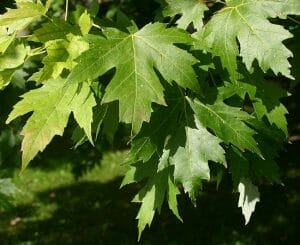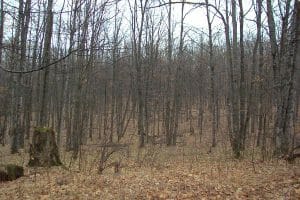Deciduous Trees Definition
Deciduous trees lose their leaves at the end of their growing season. This occurs in the fall in temperate deciduous forests, and in the dry season in tropical and subtropical deciduous forests. The word deciduous is from the Latin word decidere, meaning “to fall off.” The term for leaf loss is abscission. These trees live in forests in the eastern United States, Canada, areas of Japan and China and most of Europe. Other names for deciduous trees are broadleaf trees or hardwood trees. Evergreens are trees that do not lose their leaves.
Types of Deciduous Trees
Some of the most well-known deciduous trees are:
- oak
- maple
- birch
- ash
- willow
- poplar
- aspen
- beech
- walnut
- …hundreds more
Examples of Deciduous Trees
Oak
There are about 450 species in the oak genus, Quercus, which includes trees and shrubs. Some of the more common oak species are black, English, white, red and bur. Asian oak species include Mongolian, Oriental, Japanese, daimyo and sawtooth. The broad flat leaves of the oak have lobes with toothed edges in some species. Acorns are the fruit of oak trees. Oak wood is commonly used as lumber in the construction, furniture and flooring industries.

The image above shows the leaves of an oak tree.
Maple
The maple genus, Acer, has about 200 species of trees and shrubs. Red, sugar and silver are some of the most common types. Maples are often used as ornamental trees in landscaping and in areas where shade is desired. Specialty items that come from maple trees include bowling pins, butcher blocks, baseball bats and maple syrup. Samaras are the pairs of winged seeds on maples which fall with a characteristic propeller motion. Maples provide some of the most striking fall leaf colors of all tree species.

The image above shows the leaves of a maple tree.
Birch
Birch trees have smooth white and black bark and are used for timber and ornamental purposes. Of the approximately 40 species in the birch Betula genus, some of the most common are paper, river, gray, white and yellow. Two Japanese species are monarch and cherry birch. Birch leaves are egg-shaped or triangular and have toothed edges. Birch leaves turn yellow in fall. Birch is commonly used to produce furniture, flooring, paneling, trim, cabinets and plywood. Native Americans and early settlers in North America used birch bark for making canoes, roofing and shoes.

The image above shows the leaves of a birch tree.
How Deciduous Trees Lose Their Leaves
In fall, temperate deciduous trees enter a period of dormancy when all metabolic processes start to slow down, due primarily to the decreased daylight hours. A chemical called abscisic acid is produced where the leaf and stem comes together. Abscisic acid causes the cells in that area to divide rapidly, but not grow. This action has two effects: 1) the rapid cell division causes the stem to detach from the branch and 2) the cells form a cork-like layer that stops nutrients and minerals from entering the leaf. Two plant hormones that also take part in abscission are auxin and ethylene. Temperature, soil moisture and the amount of sunlight influence the colors that appear in fall foliage before the leaves drop.
The leaves on tropical and subtropical deciduous trees fall as a mechanism to allow the tree to conserve water in the dry season. Trees at these latitudes are not subject to significantly decreased daylight hours as temperate deciduous trees are.

This image shows a temperate deciduous forest after most of the leaves have fallen.
Colors of Deciduous Tree Leaves in Fall
Deciduous trees continually replace chlorophyll throughout the warmer months. Chlorophyll is what gives leaves their green color, and it gets used up during photosynthesis. For temperate deciduous trees, as temperatures drop and daylight hours decrease in the fall, production of chlorophyll slows and eventually stops. For some tree species, the loss of chlorophyll reveals other spectacular pigments that were hidden in the leaves. The yellow, brown and orange colors commonly seen come from more than 600 kinds of carotenoid pigments. Anthocyanin pigments result in red and purple, and tannins are brown. While carotenoid pigments are always present, the leaves make anthocyanins in late summer, around the time abscission begins. Some deciduous tree species lose their leaves without any significant color change.
Quiz
1. The term abscission means _______________.
A. a tropical or subtropical forest.
B. shorter daylight hours.
C. leaf drop.
D. the dry season.
2. On which continent are deciduous trees NOT found?
A. Antarctica
B. Asia
C. North America
D. Europe
3. What main environmental cue triggers temperate deciduous trees to enter dormancy?
A. Torrential rain.
B. Colder temperatures.
C. Decreased daylight hours.
D. The dry season.
References
- Birch tree. (n.d.). In Encyclopedia Britannica online. Retrieved from https://www.britannica.com/plant/birch.
- Campbell, E. (2012, January 13). How do trees survive winter? Retrieved from http://www.mnn.com/earth-matters/wilderness-resources/stories/how-do-trees-survive-winter.
- Deciduous. (n.d.). In Merriam-Webster online. Retrieved from https://www.merriam-webster.com/dictionary/deciduous.
- Deciduous. (n.d.). In New World Encyclopedia. Retrieved from http://www.newworldencyclopedia.org/entry/Deciduous.
- Jin, X., Zimmerman, J., Polle, A., & Fischer, U. (2015). Auxin is a long-range signal that acts independently of ethylene signaling on leaf abscission in Populus. Frontiers in Plant Science. 6, 634. doi: 10.3389/fpls.2015.00634.
- Maple tree. (n.d.). In Encyclopedia Britannica online. Retrieved from https://www.britannica.com/plant/maple-tree.
- Oak tree. (n.d.). In Encyclopedia Britannica online. Retrieved from https://www.britannica.com/plant/oak.
- Patterson, S. (2017, May 9). What are deciduous trees and shrubs: Types of deciduous trees and shrubs. Retrieved from https://www.gardeningknowhow.com/ornamental/trees/tgen/what-are-deciduous-plants.htm.
- “The science of color in autumn leaves.” (2017, May 9). Retrieved from http://www.usna.usda.gov/PhotoGallery/FallFoliage/ScienceFallColor.html.
Deciduous Trees
No comments:
Post a Comment